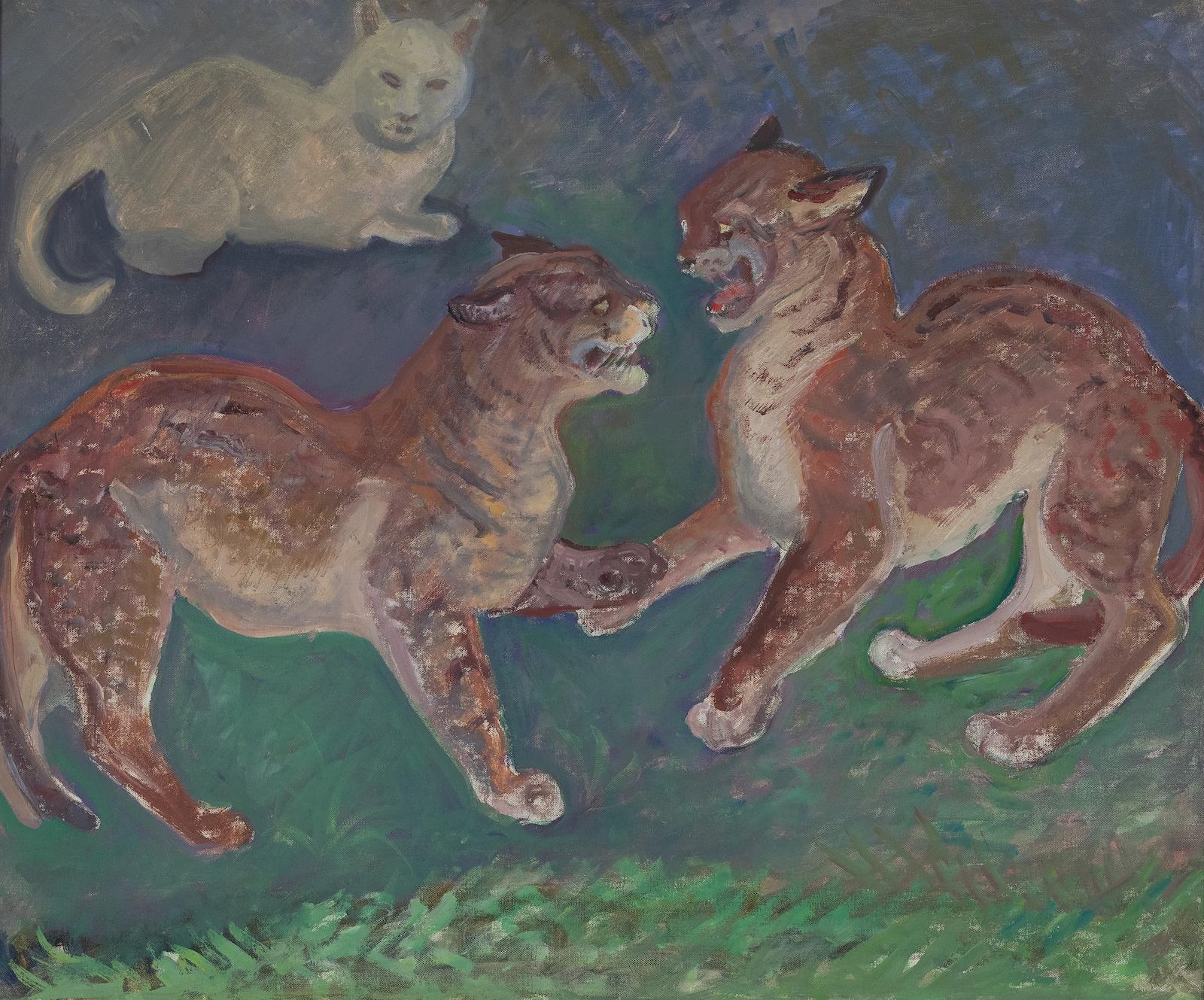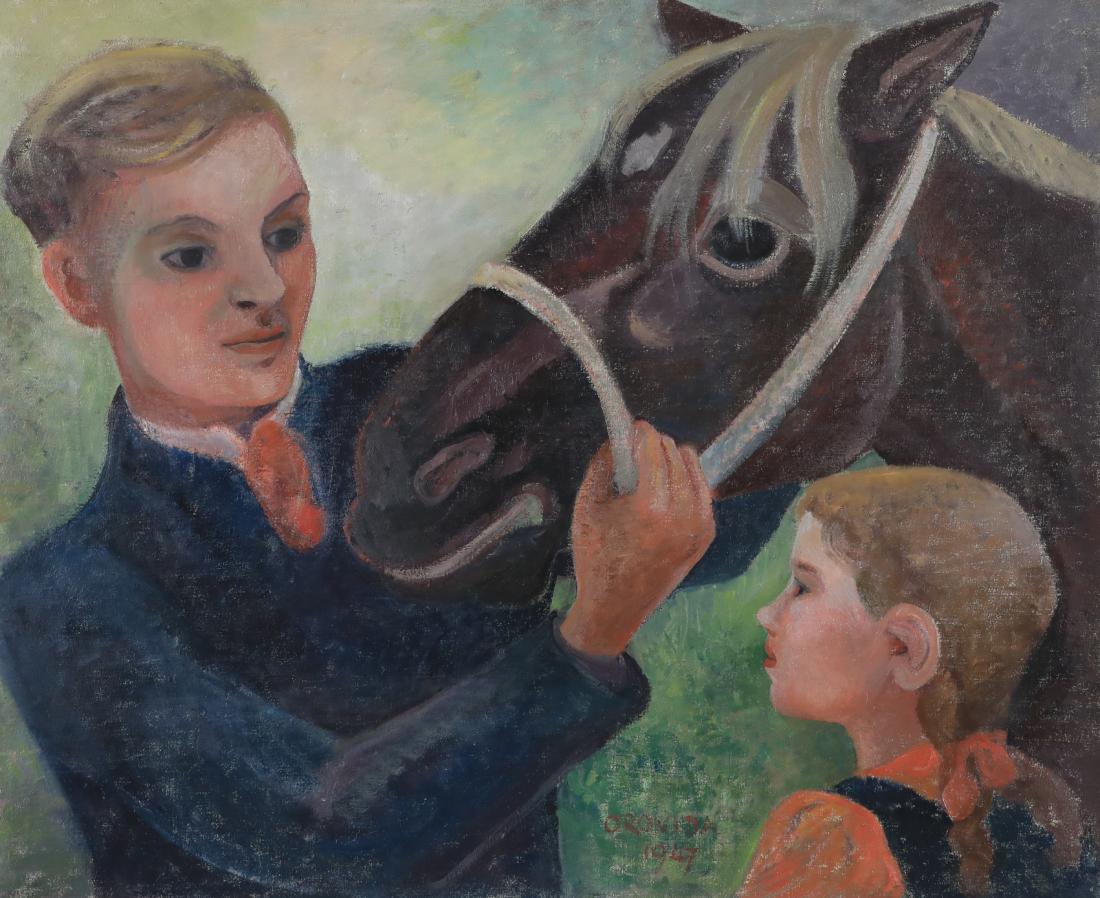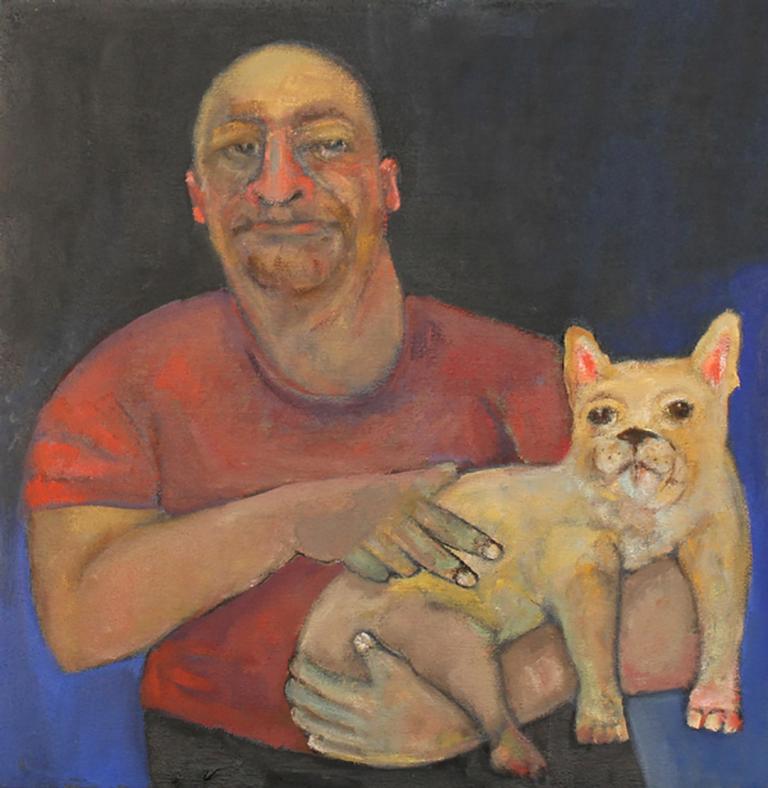Orovida PissarroTom Cat by Orovida Pissarro - Cat oil painting, 19611961
1961
About the Item
- Creator:Orovida Pissarro (1893 - 1968)
- Creation Year:1961
- Dimensions:Height: 20.08 in (51 cm)Width: 24.02 in (61 cm)
- Medium:
- Movement & Style:
- Period:
- Condition:
- Gallery Location:London, GB
- Reference Number:1stDibs: LU261213961382
Orovida Pissarro
Orovida Pissarro, the only child of Lucien and Esther Pissarro, was the first woman in the Pissarro family to become a professional artist and the first Pissarro of her generation to take up painting. Born in Epping, England, in 1893, she lived and worked predominantly in London, where she was a prominent member of several British arts clubs and societies.
Orovida first learned to paint in the Impressionist style from her father and, after a brief period of formal study with Walter Sickert in 1913, she renounced formal art schooling.
Throughout her career, Orovida always remained outside mainstream British art movements. Much to Lucien's disappointment, she soon turned away from naturalistic painting and developed an unusual style that combined elements of Japanese, Chinese, Persian and Indian art. Her rejection of Impressionism, which, for the Pissarro family, was a way of life, and her simultaneous decision to drop her famous last name and use simply Orovida as a nom de peintre, reflected a desire for independence and distance from the family legacy, of which she nevertheless remained proud.
Orovida's most distinctive works are her paintings from the 1920s and 1930s in gouache (she called her mixture body color) and tempera, applied in thin, delicate washes to silk, linen, paper or gold leaf and embellished with brocade borders. These elegant and richly decorative works generally depict non-Western subjects, for example: Mongolian horseback riders, African dancers and Persian princes, often engaged in activities such as dancing or hunting rituals.
The second half of Orovida's painting career is marked by a dramatic change in both style and subject matter. In the mid-1940s, she began to embrace contemporary subjects from everyday life and returned to a more naturalistic style. Her new style was more suited to oils, and thus, she returned to that medium.
Over the course of her life, Orovida was aware of the mixed blessing of having famous artists in the family; not only a grandfather and father but also four uncles, and towards the end of her life, she was instrumental in developing the Pissarro family archive that her mother had established at the Ashmolean Museum in Oxford.
(Biography provided by Stern Pissarro Gallery)
- ShippingRetrieving quote...Ships From: London, United Kingdom
- Return PolicyA return for this item may be initiated within 7 days of delivery.
- Caterwaul by Orovida Pissarro - Animal paintingBy Orovida PissarroLocated in London, GBCaterwaul by Orovida Pissarro (1893-1968) Oil on canvas 51 x 61 cm (20 ¹/₈ x 24 inches) Provenance Estate of the artist With John Bensusan-Butt, cousin of the artist G Hassell, 25th...Category
1950s Modern Animal Paintings
MaterialsOil, Canvas
- Migrating horses by Orovida Pissarro - Animal paintingBy Orovida PissarroLocated in London, GB*UK BUYERS WILL PAY AN ADDITIONAL 20% VAT ON TOP OF THE ABOVE PRICE Migrating horses by Orovida Pissarro (1893-1968) Oil on canvas 71.1 x 81.4 cm (28 x 32 inches) Signed and dated l...Category
1950s Modern Figurative Paintings
MaterialsOil, Canvas
- Father, Daughter and Horse by Orovida Pissarro - Oil paintingBy Orovida PissarroLocated in London, GB*UK BUYERS WILL PAY AN ADDITIONAL 20% VAT ON TOP OF THE ABOVE PRICE Father, Daughter and Horse by Orovida Pissarro (1893-1968) Oil on canvas 60 x 73 cm (23 ⅝ x 28 ¾ inches) Signed a...Category
1940s Modern Animal Paintings
MaterialsOil, Canvas
- The Cattery by Orovida Pissarro - Animal paintingBy Orovida PissarroLocated in London, GBThe Cattery by Orovida Pissarro (1893-1968) Oil and pencil on canvas 61 x 51 cm (24 x 20 ⅛ inches) Signed and dated upper right Orovida 1964 Provenance Estate of the artist G Hassel...Category
1960s Modern Animal Paintings
MaterialsOil, Canvas, Pencil
- Cat and Mouse by Orovida Pissarro - Animal paintingBy Orovida PissarroLocated in London, GBCat and Mouse by Orovida Pissarro (1893-1968) Oil on canvas 61 x 51 cm (24 x 20 ⅛ inches) Signed and dated lower centre Orovida 1948, altered by the artist in 1966 Provenance Royal ...Category
1960s Modern Animal Paintings
MaterialsCanvas, Oil
- Tiger Surprises Black Buck by Orovida Pissarro - Animal paintingBy Orovida PissarroLocated in London, GB*UK BUYERS WILL PAY AN ADDITIONAL 20% VAT ON TOP OF THE ABOVE PRICE Tiger Surprises Black Buck by Orovida Pissarro (1893-1968) Oil on canvas 127 x 101.5 cm (50 x 40 inches) Signed and dated lower left Orovida 1960 Provenance The Leicester Galleries, London, circa 1965 Literature K L Erickson, Orovida Pissarro: Painter and Print-Maker with A Catalogue Raisonné of Paintings, (doctoral thesis), Oxford, 1992, Appendices, no. 195 (illustrated) Exhibition London, Royal Society of British Artists, 3rd-25th November 1960, no. 82 (possibly; titled Tiger Entangled) London, Royal Academy, 1961, no. 534 Colchester, The Minories, 3rd- 24th March 1962 London, The Leicester Galleries, 1965, no. 37 Artist biography Orovida Camille Pissarro, Lucien and Esther Pissarro’s only child, was the first woman in the Pissarro family as well as the first of her generation to become an artist. Born in Epping, England in 1893, she lived and worked predominantly in London where she became a prominent member of several British arts clubs and societies. She first learned to paint in the Impressionist style of her father, but after a brief period of formal study with Walter Sickert in 1913 she renounced formal art schooling. Throughout her career, Orovida always remained outside of any mainstream British art movements. Much to Lucien's disappointment she soon turned away from naturalistic painting and developed her own unusual style combining elements of Japanese, Chinese, Persian and Indian art. Her rejection of Impressionism, which for the Pissarro family had become a way of life, together with the simultaneous decision to drop her famous last name and simply use Orovida as a ‘nom de peintre’, reflected a deep desire for independence and distance from the weight of the family legacy. Orovida's most distinctive and notable works were produced from the period of 1919 to 1939 using her own homemade egg tempera applied in thin, delicate washes to silk, linen or paper and sometimes embellished with brocade borders. These elegant and richly decorative works generally depict Eastern, Asian and African subjects, such as Mongolian horse...Category
1960s Modern Animal Paintings
MaterialsCanvas, Oil
- mr. c and gladys, bright colorful man and dogBy Stephen BassoLocated in Brooklyn, NY*ABOUT Stephen Basso Stephen Basso's highly original pastels and oil paintings are romantic, yet thought provoking fantasies. His whimsical works are alive with boundless imagina...Category
2010s American Modern Animal Paintings
MaterialsCanvas, Oil
- French Modernist, Beautiful Summer ButterflyBy Henri-André MartinLocated in Harkstead, GBAn incredibly striking image of a white butterfly set against a background of yellow petals. Painted with great energy and with a most appealing texture to the paint surface. This lo...Category
20th Century Modern Animal Paintings
MaterialsCanvas, Oil
- French Modernist, Beautiful Summer ButterflyBy Henri-André MartinLocated in Harkstead, GBAn incredibly striking image of a black and yellow butterfly. Painted with great energy and style. This looks stunning against a white wall. Henri-André Martin (1918-2004) A Swallowtail butterfly Signed Oil on canvas 23½ x 23½ inches excluding frame 26½ x 26½ inches including frame Provenance: The artist's studio sale Born in Lyon in 1918, Henri-André Martin spent his youth in Saint-Étienne. Following his father into the medical profession, he spent his first years studying medicine in Lyon, but also enrolled in the École de Beaux Arts during this time. Upon returning from captivity in 1942, Martin soon became director of the otolaryngology clinic at Édouard-Herriot hospital. Painting, however, remained his true calling in life - it was, to him, an invaluable form of self-expression. Reserved and extremely modest, and frequently regarded as somewhat aloof, art was a means of articulating his anxieties and apprehensions, as well as giving a voice to his inner child. Martin had a brush in hand at all times, wherever he went, and painted countless gouaches of varying sizes. His beach paintings in particular have been compared to those of Boudin. Until the 1970s, Martin had a tendency to paint ‘on the ground’, yet in all of his paintings, there is a distinct sense of distance and removal from the subject-matter. In the years that followed, we see a development in this simplification and abstraction of the subject-matter, as seen, for example, in his images of almond trees standing alone against the stark winter sky of Provence. The palette begins to darken, his work acquires a feeling of gravity, as his paintings of Hamburg Port evidently reflect. His collection entitled ‘Trunks’, six lithographic plates, draws on visual and written material in the book, L’Olivier. His interest in the symbolism of the olive tree subsequently grew, and he turned to literature, painting and historical traditions to develop and nuance his understanding of its allegorical value. This fascination with the olive tree, and more broadly, with the nature of symbolism, came to profoundly inform his later work. What he learnt to represent was not merely the physical reality of his subjects, but their implicit interconnection with abstract ideas. As René Déroudille writes, the lithographic plates are ‘especially devoted to and embrace renewal’, revealing an artist who is in ‘full mutation’. In the 1980s, Martin’s work took a more explicit turn towards abstraction. It was during this time that he produced a series of large nudes, which he entered into the major exhibition at L’Atrium in Lyon, in 1992. In the years that followed, Martin focused on animating the shapes and forms born of his imagination, eventually accomplishing this and changing his focus once again, turning to more attractive, even decorative subjects, like Japanese...Category
20th Century Modern Animal Paintings
MaterialsCanvas, Oil
- French Modernist, Beautiful Summer Swallowtail ButterflyBy Henri-André MartinLocated in Harkstead, GBAn incredibly striking image of a Swallowtail butterfly. Painted with great energy and style. This would look stunning against a white wall. Henri-André Martin (1918-2004) A Swallowtail butterfly Signed Oil on canvas 23½ x 23½ inches excluding frame 26½ x 26½ inches including frame Provenance: The artist's studio sale Born in Lyon in 1918, Henri-André Martin spent his youth in Saint-Étienne. Following his father into the medical profession, he spent his first years studying medicine in Lyon, but also enrolled in the École de Beaux Arts during this time. Upon returning from captivity in 1942, Martin soon became director of the otolaryngology clinic at Édouard-Herriot hospital. Painting, however, remained his true calling in life - it was, to him, an invaluable form of self-expression. Reserved and extremely modest, and frequently regarded as somewhat aloof, art was a means of articulating his anxieties and apprehensions, as well as giving a voice to his inner child. Martin had a brush in hand at all times, wherever he went, and painted countless gouaches of varying sizes. His beach paintings in particular have been compared to those of Boudin. Until the 1970s, Martin had a tendency to paint ‘on the ground’, yet in all of his paintings, there is a distinct sense of distance and removal from the subject-matter. In the years that followed, we see a development in this simplification and abstraction of the subject-matter, as seen, for example, in his images of almond trees standing alone against the stark winter sky of Provence. The palette begins to darken, his work acquires a feeling of gravity, as his paintings of Hamburg Port evidently reflect. His collection entitled ‘Trunks’, six lithographic plates, draws on visual and written material in the book, L’Olivier. His interest in the symbolism of the olive tree subsequently grew, and he turned to literature, painting and historical traditions to develop and nuance his understanding of its allegorical value. This fascination with the olive tree, and more broadly, with the nature of symbolism, came to profoundly inform his later work. What he learnt to represent was not merely the physical reality of his subjects, but their implicit interconnection with abstract ideas. As René Déroudille writes, the lithographic plates are ‘especially devoted to and embrace renewal’, revealing an artist who is in ‘full mutation’. In the 1980s, Martin’s work took a more explicit turn towards abstraction. It was during this time that he produced a series of large nudes, which he entered into the major exhibition at L’Atrium in Lyon, in 1992. In the years that followed, Martin focused on animating the shapes and forms born of his imagination, eventually accomplishing this and changing his focus once again, turning to more attractive, even decorative subjects, like Japanese...Category
20th Century Modern Animal Paintings
MaterialsCanvas, Oil
- French Modernist, Beautiful Summer Red Admiral ButterflyBy Henri-André MartinLocated in Harkstead, GBAn incredibly striking image of a Red Admiral butterfly set against a background of petals. Painted with great energy and with a most appealing texture to the paint surface. Looks re...Category
20th Century Modern Animal Paintings
MaterialsCanvas, Oil
- French Modernist, Beautiful Summer ButterflyBy Henri-André MartinLocated in Harkstead, GBAn incredibly striking image of a white butterfly set against a background of yellow petals. Painted with great energy and with a most appealing texture to the paint surface. This lo...Category
20th Century Modern Animal Paintings
MaterialsOil, Canvas






